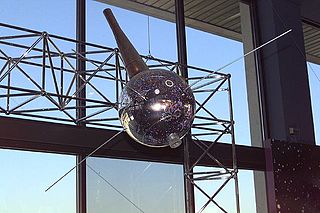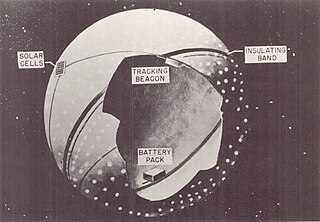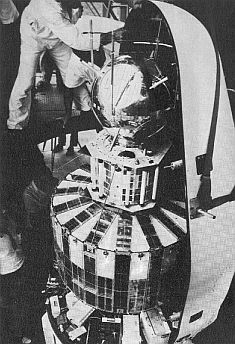
Vanguard 1 is an American satellite that was the fourth artificial Earth-orbiting satellite to be successfully launched, following Sputnik 1, Sputnik 2, and Explorer 1. It was launched 17 March 1958. Vanguard 1 was the first satellite to have solar electric power. Although communications with the satellite were lost in 1964, it remains the oldest human-made object still in orbit, together with the upper stage of its launch vehicle.
Project Vanguard was a program managed by the United States Navy Naval Research Laboratory (NRL), which intended to launch the first artificial satellite into low Earth orbit using a Vanguard rocket. as the launch vehicle from Cape Canaveral Missile Annex, Florida.

Vanguard 3 is a scientific satellite that was launched into Earth orbit by the Vanguard SLV-7 on 18 September 1959, the third successful Vanguard launch out of eleven attempts. Vanguard rocket: Vanguard Satellite Launch Vehicle-7 (SLV-7) was an unused Vanguard TV-4BU rocket, updated to the final production Satellite Launch Vehicle (SLV).
The Vanguard rocket was intended to be the first launch vehicle the United States would use to place a satellite into orbit. Instead, the Sputnik crisis caused by the surprise launch of Sputnik 1 led the U.S., after the failure of Vanguard TV-3, to quickly orbit the Explorer 1 satellite using a Juno I rocket, making Vanguard 1 the second successful U.S. orbital launch.

Vanguard TV-3BU, also called Vanguard Test Vehicle-Three Backup, was the second flight of the American Vanguard rocket. An unsuccessful attempt to place an unnamed satellite, Vanguard 1B, into orbit, the rocket was launched on 5 February 1958. It was launched from LC-18A at the Cape Canaveral Air Force Station. Fifty-seven seconds after launch, control of the vehicle was lost and it failed to achieve orbit. At 57 seconds, the booster suddenly pitched down. The skinny second stage broke in half from aerodynamic stress, causing the Vanguard to tumble end-over-end before a range safety officer sent the destruct command. The cause of the failure was attributed to a spurious guidance signal that caused the first stage to perform unintended pitch maneuvers. Vanguard TV-3BU only reached an altitude of 6.1 km (3.8 mi), the goal was 3,840 km (2,390 mi).

Explorer 9, known as S-56A before launch, was a NASA satellite which was launched in February 1961 to study the density and composition of the upper thermosphere and lower exosphere. It was a reflight of the failed Explorer S-56 mission, and consisted of a 7 kg (15 lb), 3.66 m (12.0 ft) balloon which was deployed into a medium Earth orbit. The mission was conducted by NASA's Langley Research Center.

Vanguard TV-0, also called Vanguard Test Vehicle-Zero, was the first sub-orbital test flight of a Vanguard rocket as part of the Project Vanguard.

Vanguard TV-1, also called Vanguard Test Vehicle-One, was the second sub-orbital test flight of a Vanguard rocket as part of the Project Vanguard. Vanguard TV-1 followed the successful launch of Vanguard TV-0 a one-stage rocket launched in December 1956.

Vanguard TV-2, also called Vanguard Test Vehicle-Two, was the third suborbital test flight of a Vanguard rocket as part of Project Vanguard. Successful TV-2 followed the successful launch of Vanguard TV-0 a one-stage rocket launched in December 1956 and Vanguard TV-1 a two-stage rocket launched in May 1957.

Vanguard TV-5, also called Vanguard Test Vehicle-Five, was a failed flight of the American Vanguard rocket following the successful launch of Vanguard 1 on Vanguard TV-4. Vanguard TV-5 launched on 29 April 1958 at 02:53:00 GMT, from Launch Complex 18A at the Cape Canaveral Air Force Station. The rocket was unsuccessful in its attempt to place an unnamed satellite into orbit.

Vanguard SLV-1, also called Vanguard Satellite Launch Vehicle-1 was hoped to be the second successful flight of the American Vanguard rocket following the successful launch of the Vanguard 1 satellite on rocket Vanguard TV-4 in March 1958.

Vanguard SLV-2, also called Vanguard Satellite Launch Vehicle-2 hoped to be the second successful flight of the American Vanguard rocket following successful Vanguard 1 satellite on rocket Vanguard TV-4.

Vanguard SLV-3, also called Vanguard Satellite Launch Vehicle-3 hoped to be the second successful flight of the American Vanguard rocket following successful Vanguard 1 satellite on rocket Vanguard TV-4.

Vanguard SLV-5, also called Vanguard Satellite Launch Vehicle-Five hoped to be the third successful flight of the American Vanguard rocket following the successful Vanguard 2 satellite on rocket Vanguard SLV-4.

Vanguard SLV-6, also called Vanguard Satellite Launch Vehicle-Six, hoped to be the third successful flight of the American Vanguard rocket following the successful Vanguard 2 satellite on rocket Vanguard SLV-4. Vanguard Satellite Launch Vehicle-6 (SLV-6) was designed to carry a small spherical satellite into Earth orbit to study solar heating of Earth and the heat balance. A faulty second stage pressure valve caused a mission failure.

Explorer 19,, was a NASA satellite launched on 19 December 1963, as part of the Explorer program. It was the third of six identical Explorer satellites launched to study air density and composition, and the second to reach orbit. It was identical to Explorer 9.

Explorer 24 was a NASA satellite designed for atmospheric studies. Explorer 24 was launched on 21 November 1964 from Vandenberg Air Force Base, Lompoc, California, with a Scout X-4. Explorer 24 was launched along with its successor satellite, Explorer 25.

Explorer 39, also known as AD-C, was a NASA scientific satellite belonging to series Air Density. It was launched on 8 August 1968, join with Explorer 40, from Launch Complex 5 of the Vandenberg Air Force Base, through a Scout launch vehicle.

SOLRAD 2 was the public designation for a combination surveillance and solar X-rays and ultraviolet scientific satellite, the second in the SOLRAD program developed by the United States Navy's Naval Research Laboratory. The SOLRAD scientific package aboard the satellite provided cover for the GRAB electronic surveillance package, the mission of which was to map the Soviet Union's air defense radar network.

SOLRAD 3 was a solar X-ray satellite, the third in the SOLRAD program. Developed by the United States Navy's Naval Research Laboratory (USNRL), it shared satellite space with and provided cover for the Navy's GRAB 2, a secret electronic surveillance program.















